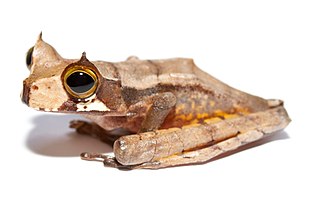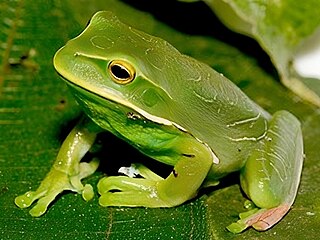
A tadpole or polliwog is the larval stage in the biological life cycle of an amphibian. Most tadpoles are fully aquatic, though some species of amphibians have tadpoles that are terrestrial. Tadpoles have some fish-like features that may not be found in adult amphibians such as a lateral line, gills and swimming tails. As they undergo metamorphosis, they start to develop functional lungs for breathing air, and the diet of tadpoles changes drastically.

Agalychnis callidryas, commonly known as the red-eyed tree frog or red-eyed leaf frog, is a species of frog in the subfamily Phyllomedusinae. It is one of the most recognizable frogs. It is native to forests from Central America to north-western South America. This species is known for its bright coloration, namely its vibrant green body with blue and yellow stripes on the side. It has a white underside, brightly red and orange colored feet, and is named after its distinctive bright red eyes. One particular and special feature of the frogs coloration is its exceptional high reflectance in the near-infrared.

Gastrotheca is a genus of frogs in the family Hemiphractidae. They are found in Central America south of Costa Rica and in South America. Most species occur in the American Cordillera from southern Costa Rica to north-western Argentina. This genus makes up the bulk of marsupial frog diversity; formerly it was placed in the "Leptodactylidae" assemblage.

Cryptobatrachus is a genus of frogs in the family Hemiphractidae. They are found in Colombia and Venezuela. They are also known as backpack frogs, as the females have the habit of carrying their egg clutch on their backs until the young hatch; this behavior also occurs in the related hemiphractid genera Hemiphractus and Stefania.

Stefania is a genus of frogs in the family Hemiphractidae. They are native to the highlands of the Guiana Shield in southern Venezuela, Guyana, and adjacent far northern Brazil. Most are restricted to the tepui highlands, but S. evansi also occurs in lowlands. On most mountains there are only 1–2 species from this genus, but five are known from Mount Ayanganna and the neighbouring Mount Wokomung has six species. They are usually found near streams at low levels on branches/leaves or on the ground among vegetation/rocks.

Hemiphractus is a genus of frogs, the horned treefrogs, in the family Hemiphractidae. These overall brownish frogs have a pointed snout and a casque on the head. They are nocturnal, relatively rare and native to humid lowland and highland forests in northern South America and Panama, where typically found on the ground or at relatively low levels in vegetation.

The marsupial frogs are a disputed family (Amphignathodontidae) in the order Anura. When treated as a separate family, it consists of two genera, Gastrotheca and Flectonotus. The frogs are native to Neotropical America. Under the dominant view, they are treated as part of the family of Hemiphractidae.

Cryptobatrachus boulengeri, also known as Boulenger's backpack frog, is a species of frogs in the family Hemiphractidae. It is endemic to Sierra Nevada de Santa Marta in northern Colombia. The specific name honours George Albert Boulenger, an eminent herpetologist.
Cryptobatrachus fuhrmanni commonly known as Fuhrmann's backpack frog is a species of frog belonging to the family Hemiphractidae. It is endemic to Colombia and occurs on all three Andean cordilleras: the eastern slope of the Cordillera Occidental, the northern and eastern flanks of the Cordillera Central, and the western slope of the Cordillera Oriental. The specific name fuhrmanni is in honor of Otto Fuhrmann, a Swiss zoologist and helminthologist.

Gastrotheca albolineata is a frog species in family Hemiphractidae. It is endemic to southeastern Brazil and known from São Paulo, Rio de Janeiro, and Espírito Santo states at elevations of 600–1,400 m (2,000–4,600 ft) asl.
Gastrotheca andaquiensis, commonly known as the Andes marsupial frog, is a species of frog in the family Hemiphractidae. It is found on the Amazonian slopes of the Andes in southern Colombia and Ecuador.

The horned marsupial frog, originally named Nototrema cornutum (Boulenger) after the first describer George Albert Boulenger in 1898), is a species of frog in the family Hemiphractidae. It is an arboreal species found in Colombia, Costa Rica, Ecuador and Panama. Its natural habitats are tropical moist lowland forests and montane cloud forests. It is threatened by habitat loss.

Gastrotheca excubitor is a species of frog in the family Hemiphractidae. It is endemic to southern Peru and occurs in the Amazonian slopes and crests of the Cordillera Oriental in the Cusco Region; records from the Cajamarca Region are likely erroneous. It is likely to include cryptic species. Common name Abra Acanacu marsupial frog has been coined for it.

Gastrotheca monticola is a species of frog in the family Hemiphractidae. It is endemic to Peru; records from Ecuador probably refer to other species. Gastrotheca lojana was formerly considered a subspecies of this species, but is now treated as a full species.

The Andean marsupial tree frog, also known as the Riobamba marsupial frog or Riobamba pouched frog, is a species of frog in the family Hemiphractidae. It is endemic to Ecuador. The species is confined to the Andes and the inter-Andean valleys, from Imbabura south to Chimborazo. They live in an altitude of 2,200–3,500 meters (7,200–11,500 ft) above sea-level. The Andean marsupial tree frog's habitat varies from the montane forests to the dry rocky hillsides, and from the agave plants to the corn fields. Once a common species, it is threatened by severe habitat loss.

Hemiphractus fasciatus, or the banded horned treefrog, is a species of frog in the family Hemiphractidae. It is found in northwestern Ecuador and possibly the Pacific slopes of the Cordillera Occidental in Colombia; although formerly listed for Panama, this involves the similar and closely related H. elioti, H. kaylockae and H. panamensis. It is a relatively large frog that may readily bite.
Stefania ayangannae is a species of frog in the family Hemiphractidae. It is endemic to Guyana where it is known from Mount Ayanganna and Mount Wokomung, both in the Pacaraima Mountains.

Stefania evansi is a species of frog in the family Hemiphractidae. Stefania evansi is, along with other closely related frogs, known for its unusual reproductive mode where females carry the eggs and juveniles on their back. It is sometimes known under common names Groete Creek carrying frog, Groete Creek treefrog, or Evans' stefania. These names refer to its type locality, Groete Creek in the region Essequibo Islands-West Demerara, Guyana, where the holotype was collected by one Dr. R. Evans.
Stefania goini is a species of frog in the family Hemiphractidae. It is endemic to Amazonas, Venezuela, and known from Cerro Duida and the nearby Cerro Huachamacari. Its natural habitats are streams on the tops of tepuis. It usually occurs on rocks.
Stefania roraimae is a species of frog in the family Hemiphractidae. It is endemic to Guyana. Its type locality is Mount Roraima; it is also known from Mount Ayanganna and Mount Wokomung. It presumably occurs in the adjacent Venezuela and Brazil too.













